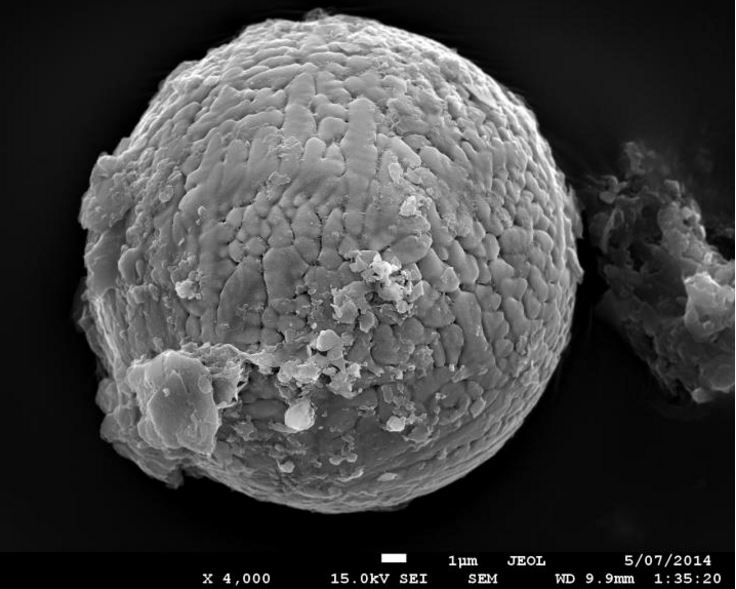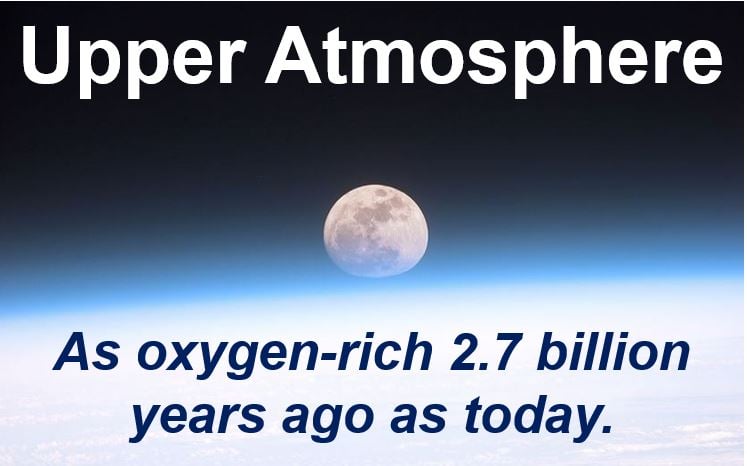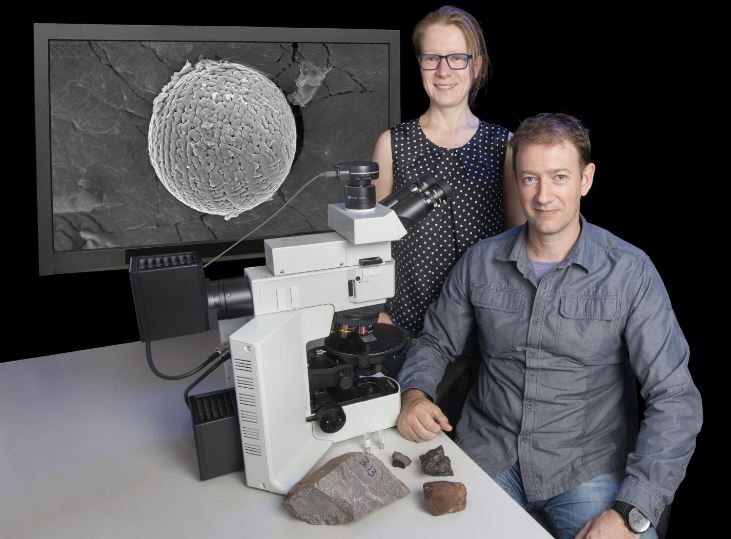The upper atmosphere of early Earth – 2.7 billion years ago – was as rich in oxygen as it is today, says a team of scientists from Imperial College London, the Australian Synchrotron and Monash University.
The researchers, who published their findings in the prestigious journal Nature (citation below), explained that they gleaned fresh insights into the chemistry of early Earth’s atmosphere by analysing fossilised *micrometeorites.
* Micrometeorites are extraterrestrial particles with a maximum width of 2 mm (0.0787 of an inch).
 One of 60 micrometeorites extracted from 2.7 billion year old limestone, from the Pilbara region. These micrometeorites consist of iron oxide minerals that formed when dust particles of meteoritic iron metal were oxidised as they entered Earth’s atmosphere, suggesting that the ancient upper atmosphere was surprisingly oxygen-rich. (Image: eurekalert.org. Credit: Adrew Tomkins)
One of 60 micrometeorites extracted from 2.7 billion year old limestone, from the Pilbara region. These micrometeorites consist of iron oxide minerals that formed when dust particles of meteoritic iron metal were oxidised as they entered Earth’s atmosphere, suggesting that the ancient upper atmosphere was surprisingly oxygen-rich. (Image: eurekalert.org. Credit: Adrew Tomkins)
Evidence suggests that our planet’s upper atmosphere 2.7 billion years ago contained similar amounts of oxygen to what there is today. It also indicates that a methane haze layer separated it from the oxygen-poor lower atmosphere.
The authors said their findings challenge the widely-accepted view that 2.7 billion years ago all of Earth’s ancient atmosphere was oxygen poor.
Different layers in atmosphere did not mix
Dr. Matthew Genge, Senior Lecturer in Earth & Planetary Science at Imperial College’s Department of Earth Science & Engineering, and colleagues suggest that their results could be explained if Earth at that time had an atmosphere that hardly mixed between the different layers.
The authors suggest that perhaps the methane haze layer at middle levels absorbed UV light from the Sun. This would have released heat and created a warm zone that would prevent the different layers from mixing.
 This latest study challenges the long-held belief that the upper atmosphere was oxygen-starved 2.7 billion years ago. (Image: Wikipedia)
This latest study challenges the long-held belief that the upper atmosphere was oxygen-starved 2.7 billion years ago. (Image: Wikipedia)
The researchers suggest that the upper oxygen layer could have been produced when CO2 was broken down by the Sun’s ultraviolet light.
Micrometeorites, also known as cosmic dust, no more than the width of a human hair, are continuously raining down on Earth.
Study leader Dr. Andrew Tomkins, who works at Monash University’s School of Earth, Atmosphere & Environment, and colleagues analysed ancient micrometeorite samples that had landed on Earth billions of years ago. The samples, which were gathered in the Pilbara region of Western Australia, were eventually encased in limestone deposits.
Methane haze prevented oxygen from seeping down
Dr. Genge, an expert in modern cosmic dust, made the following comment regarding micrometeorites:
“These micrometeorites act like little treasure chests storing information about our ancient atmosphere. Unlocking their secrets revealed a surprise because it has been firmly established that the Earth’s lower atmosphere was very poor in oxygen 2.7 billion years ago.”
“So how the upper atmosphere could contain so much oxygen before the appearance of photosynthetic organisms was a real puzzle to us. We now think Earth’s methane haze may have prevented mixing between the levels, creating an ancient atmospheric layer-cake effect where oxygen was abundant on the outer layer.”
 Dr. Andrew Tomkins and Dr. Sasha Wilson with an image of an Archean Micrometeorite (Image: monash.edu. Credit: Steven Morton)
Dr. Andrew Tomkins and Dr. Sasha Wilson with an image of an Archean Micrometeorite (Image: monash.edu. Credit: Steven Morton)
The scientists examined the cosmic dust particles using state-of-the-art microscopes from MCEM (Monash Centre for Electron Microscopy) and the *Australian Synchrotron.
* The Australian Synchrotron is a 3 GeV synchrotron facility. It is a light-source facility (as opposed to a collider), which uses particle accelerators to produce a beam of very high energy electrons that are boosted to almost the speed of light and directed into a storage rind.
They found that the ancient meteorites started off as particles of metallic iron, which when exposed to oxygen and warmed up by friction in the upper atmosphere turned into iron oxide minerals.
“Using cutting-edge microscopes we found that most of the micrometeorites had once been particles of metallic iron – common in meteorites – that had been turned into iron oxide minerals in the upper atmosphere, indicating higher concentrations of oxygen than expected.”
“This was an exciting result because it is the first time anyone has found a way to sample the chemistry of the ancient Earth’s upper atmosphere,” Dr Tomkins said.
According to Dr. Genge’s calculations, the micrometeorites could only have turned into iron oxide minerals if the oxygen levels in the upper atmosphere 2.7 billion years ago had been similar to what they are today.
 Dr. Matthew Genge’s research interests focus on meteoritics and planetary science and terrestrial igneous petrology. He is also interested in the formation of planetary systems, the origins of life on Earth, astrobiology, and Mars. (Image: imperial.ac.uk)
Dr. Matthew Genge’s research interests focus on meteoritics and planetary science and terrestrial igneous petrology. He is also interested in the formation of planetary systems, the origins of life on Earth, astrobiology, and Mars. (Image: imperial.ac.uk)
Micrometeorites – treasure troves of useful data
Dr. Tomkins expressed his amazement at how much data ancient cosmic dust can give us with the following comment:
“It is incredible to think that by studying ancient space dust particles the width of a human hair, we can gain new insights into the chemical makeup of Earth’s upper atmosphere, billions of years ago.”
In an Abstract in the journal, the authors wrote:
“Our model of atmospheric micrometeorite oxidation suggests that Archaean upper-atmosphere oxygen concentrations may have been close to those of the present-day Earth, and that the ratio of oxygen to carbon monoxide was sufficiently high to prevent noticeable inhibition of oxidation by carbon monoxide.”
“The anomalous sulfur isotope (Δ33S) signature of pyrite (FeS2) in seafloor sediments from this period, which requires an anoxic surface environment4, implies that there may have been minimal mixing between the upper and lower atmosphere during the Archaean.”
The research team now plans to search for micrometeorites within rocks of different ages to determine how Earth’s ancient atmosphere changed after photosynthetic organisms 2.5 billion years ago started producing oxygen, during the Great Oxidation Event.
Dr. Genge and his group of researchers at Imperial are currently focusing on studying modern micrometeorites in Antarctica, as well as those gathered from rocks from 2.7 billion years ago until recently. The team wants to find out how Earth’s climate has evolved.
Citation: “Ancient micrometeorites suggestive of an oxygen-rich Archaean upper atmosphere,” Andrew G. Tomkins, Lara Bowlt, Matthew Genge, Siobhan A. Wilson, Helen E. A. Brand & Jeremy L. Wykes. Nature 533, 235–238. 12 May 2016. DOI:10.1038/nature17678.
Video – Dr. Andy Tomkins, Meteorite Hunter
By studying rocks from space up to 4.5 billion years old, Geologist Dr. Andrew Tomkins is uncovering clues to the origins of our solar system.
